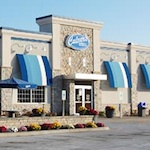At a Glance
Company headquarters
Greensboro, NC
Construction/facilities employees
10
Average project duration
12 months
Current locations
39
In their traditional strip layout, it’s unlikely any outlet malls were ever seen as remarkable structures, positioned as they typically were along multilane highways, far away from larger metropolitan areas. Contemporary outlet-mall developers, though, have been working to change this perception, and their efforts are finally starting to show themselves in new mall designs and a move toward construction nearer to city centers—shifts that Carl Close and Tanger Factory Outlet Centers, Inc. have enjoyed being at the front of.
Close is the assistant vice president of construction for Tanger, an outlet-mall chain founded by Stanley K. Tanger. Tanger helped pioneer the modern outlet-mall industry by building the first such shopping center in Burlington, North Carolina, in 1981, and today the company operates 38 centers in 25 states and one in Ontario, Canada. Each location is approximately 330,000 square feet, with 80 to 90 stores, and new ones are built every year. Close is responsible for overseeing each of the build-outs, which these days are typically laid out in a racetrack formation, perhaps the biggest change to outlet-mall design in recent history.
The racetrack design’s key feature is a pedestrian walkway laid out roughly in the shape of a digital figure eight, with stores inside and outside the lines of the numeral. “With a racetrack configuration, there are four to six [street] entry points into the outlet, and all the store entries are on the inside,” Close says. “Our buildings are typically 100 feet deep, and once you enter, you are in a pedestrian courtyard that is 35 feet wide and goes to the left and right. No outside entry comes through the tenant space. The interior is an open-air environment.”

This design fundamentally changes the way patrons interact with outlet stores, Close says. “In a strip mall’s U format, it would take 45 or 50 minutes to walk from one side to the other,” he explains. “If you take the same-size center in a racetrack format, a person can be back at their starting point in less than 20 minutes, and they’ve seen everything. … The potential for impulse buying is more significant because every store is within reach no matter where they are.”
Most recently, in November 2012, Tanger implemented the racetrack layout for its 39th outlet—Westgate at Glendale, Arizona. Close and his team added some finishing touches to configure the center for the hot Arizona climate. “For air circulation, we installed 10 large, high-powered Big Ass Fans and put a hard roof over the hardscape area slope so that the low end is to the south and west to block the afternoon sun,” he says.
The efficient fans were a special touch, and Tanger Outlets doesn’t always seek LEED certification. However, it does strive for a level of energy efficiency by including fluorescent fixtures where possible, low-flow toilets in common areas, white roofs, drip irrigation, and local, drought-tolerant plants.
With all these consumer-friendly measures, outlet malls are becoming more popular and accepted, creeping into larger population centers and nearer to other retailers. “In Branson, Missouri, and Osage Beach, Missouri, you can look across the valley and see a Walmart in the distance,” Close says, noting at the same time, though, that Tanger’s presence has actually helped the other businesses. “In both cases, the Walmarts reported an 18 percent increase in sales when the outlet centers opened. [Before], we would be 60 or 80 miles from a metropolitan area and nowhere near a Walmart.”
Going forward, Close anticipates that as real estate becomes more scarce and valuable, outlets could “go vertical” with multiple parking and shopping levels. Whether the centers go up or out, however, Tanger will continue to find ways to improve upon its consumer-driven design. ABQ
_____________________

Meet Carl Close
Where did you go to school?
I was born and raised in Pittsburgh, Pennsylvania, but my parents moved to Switzerland when I was in high school. I lived there for eight years but came back here to go to college at Colgate University [CU] while still living in Switzerland. At CU, I received a BA in fine arts, specializing in architecture.
What was your first construction job?
Building a steel plant in Erie, Pennsylvania. I worked for the general contractor as part of the survey team.
How did you come to work for Tanger Outlets?
I started as a consultant in June 1997. I actually didn’t become an employee until November 2011. I consulted a little over 14 years.
What personal goals do you have in your current role?
I’m just enjoying life at this point. I love doing what I do and want to keep working as long as I can.


